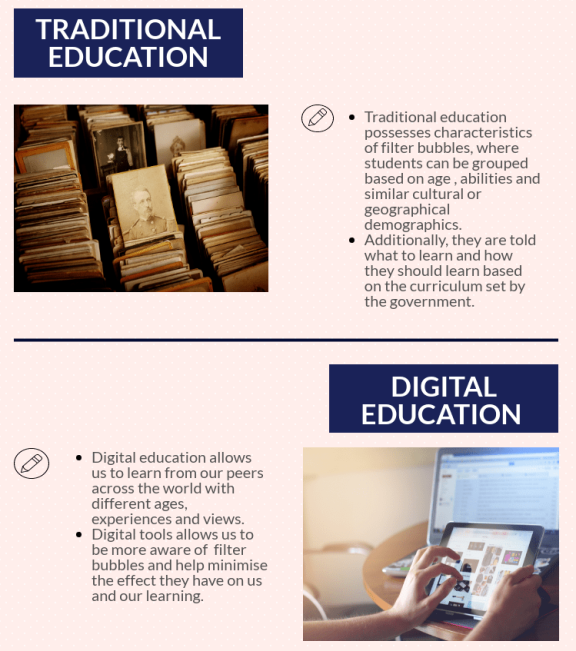Looking back at my last blog, I learned that our personal learning networks can be restricted due to digital differences. This week, I have been able to further develop my understanding of online learning as I researched and evaluated the reliability of online sources.
I came across various concepts such as ‘filter bubbles’ and ‘echo chambers’ and the damaging impact of ‘fake news’, which I illustrate and discuss in my Topic 2 blog. More importantly, I realised how such algorithm bias’ have impacted my own Internet use through social networking sites such as Facebook, and how my real life decisions have been influenced, which I briefly discussed with Chloe on my blog. She pointed out research which found that users who come across content with differing opinions are less likely to engage on such sites, which I can subconsciously relate to.
Additionally, I have learnt that our skills which allow us to assess authenticity of online information largely stems from digital education, which I have discussed individually with multiple bloggers: Bivash, Karishma and Sam.
Bivash interestingly pointed out how ‘traditional education’ vs new digital education affects our relation with filter bubbles:

More over, Karishma also presents light towards a new game which aims to help young people spot ‘fake news’ more efficiently, supporting mine and Bivash’s attitude towards the importance of digital education. However, I still believe, despite new forms of education, we must also incorporate other strategies such as supporting investigative journalism and reduce financial incentives for fake news, to ensure all Internet users are addressed (not just the new generation).
Through my evaluation I have realised fact-checking is a good starting point when addressing online information.

Ultimately, improving our media literacy skills and checking the reliability and authenticity of sources allows us to thrive in a ‘social media driven world’.
Word Count: 301 words
My comment on Bivash’s blog
My comment on Karishma’s blog
References:
- A.Kakur (2018) BBC launches ‘fake news’ game for young people that puts them at ‘heart of newsroom’ amid a breaking news story. Available at: http://pressgazette.co.uk/bbc-launches-fake-news-game-for-young-people-that-puts-them-at-heart-of-newsroom-amid-a-breaking-news-story/
- C.Grevet, L.G.Terveen, E.Gilbert (2014). Managing political differences in social media. In Proceedings of the 17th ACM conference on Computer supported cooperative work & social computing (pp. 1400-1408) Available at: https://experts.umn.edu/en/publications/managing-political-differences-in-social-media
- Beck.L. (2017) Fact Checking in a Fast-Paced Social Media Driven World. Tedtalk








